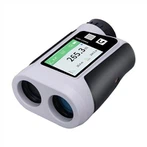Infrared thermometer impact response
Faults in electrical equipment, whether they are caused by the current effect of heating faults (faults in conductive circuits), the heating power is proportional to the square of the value of the load current. Voltage effect caused by heating faults (insulation medium failure), the heating power and operating voltage is proportional to the square. Therefore, the size of the operating voltage and load current of the equipment will directly affect the effectiveness of infrared detection and fault diagnosis. The increase in leakage current can cause uneven voltage in some parts of the high-voltage equipment. If there is no loaded operation or the load is very low, it will make the equipment fault heating is not obvious, even if there is a more serious fault, it is unlikely to be exposed by the characteristic thermal anomaly form. Only when the equipment is running at the rated voltage, and the higher the load, the more serious the heating and temperature rise, and the more obvious the characteristic thermal anomalies at the point of failure are exposed. Therefore, in infrared detection, in order to achieve reliable detection results, to try to ensure that the equipment in the rated voltage and full-load operation, even if it can not do continuous full-load operation, but also should be prepared for a running programme, so that in the detection process before and during the test, the equipment can be run at full load for a period of time (eg, 4 ~ 6h), so that the faulty parts of the equipment have enough time to heat up and ensure that the surface of the stability of the temperature rise. Temperature rise.
Due to electrical equipment failure infrared diagnosis, fault judgement criteria is often based on the temperature rise of the equipment at rated current, so when the test when the actual operating current is less than the rated current, it should be the site of the actual measurement of the equipment failure point temperature rise converted to the temperature rise of the rated current.
Infrared thermometer wavelength range
The emissivity and surface properties of the target material determine the spectral response or wavelength of the pyrometer. For highly reflective alloy materials, there are low or variable emissivities. In the high temperature region, the *best* wavelength for measuring metallic materials is near infrared, which can be selected from 0.18-1.0μm wavelength. In other temperature zones, wavelengths of 1.6 μm, 2.2 μm and 3.9 μm are available. As some materials at a certain wavelength is transparent, infrared energy will penetrate these materials, such materials should choose a special wavelength. Such as measuring the internal temperature of glass choose 10μm, 2.2μm and 3.9μm (the measured glass should be very thick, otherwise it will pass through) wavelength; measuring the internal temperature of glass choose 5.0μm wavelength; measuring the low area of the selection of 8-14μm wavelength is appropriate; and then such as measuring the selection of polyethylene plastic film 3.43μm wavelength, the polyvinyl acetate class choose 4.3μm or 7.9μm wavelength. Thickness of more than 0.4mm choose 8-14μm wavelength; and such as measuring the flame in the C02 with a narrow band of 4.24-4.3μm wavelength, measuring the flame in the C0 with a narrow band of 4.64μm wavelength, measuring the flame in the N02 with 4.47μm wavelength.






